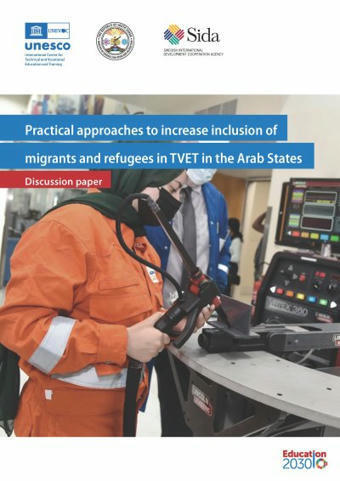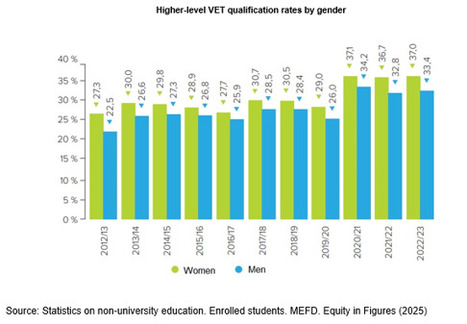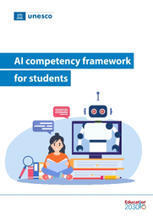 Your new post is loading...
 Your new post is loading...
Vancouver, July 2025 — The Canadian Vocational Association (CVA-ACFP) delivered a DACUM I training workshop in Vancouver, British Columbia, for a select group of professionals from WorkSafeBC. The five-day training, led by John Avery (President of CVA-ACFP and DACUM trainer) and Bruno Chauvel (CVA-ACFP DACUM trainer), marked a significant milestone in the advancement of competency-based methodologies within WorkSafeBC, British Columbia’s provincial agency responsible for promoting workplace health and safety, preventing injuries, and supporting return-to-work programmes for injured workers.
This study explores the use of analytical artificial intelligence (AI) to enhance lesson planning in teacher education, particularly in vocational business education. Providing detailed, individualized feedback for lesson planning is challenging for university instructors. An analytical AI platform that offers expert-level feedback on lesson plans could be a suitable supplement to traditional feedback as it balances out critical aspects of generative AI systems. In a longitudinal study with 103 participants, an experimental group received AI feedback on the lesson plans they developed throughout a semester, while a control group received human feedback. Results indicate that AI feedback can match or surpass human feedback in some dimensions, improving planning aspects like certain content-related sustainability aspects, action orientation, relatedness or even technology use, lesson structure, and learner engagement. Besides the integration of didactic planning dimensions into the lesson plans, this study looked at student motivation, self-reported AI literacy, AI attitudes, self-efficacy with digital technologies and digital competences. Results of these meta-dimensions show that the mere use of AI does not automatically enhance AI literacy, change attitudes or improve motivation. The study suggests that as a consequence, analytical AI platforms can effectively supplement traditional feedback but should be used within a holistic framework.
The dual system in Austria depends on companies’ willing and ability to train apprentices. This is done on a voluntary basis and, so businesses must weigh the costs against the benefits. The latest analyses reveal that this investment pays off for many businesses, both economically and through various non-monetary benefits.
Since the 1970s, regular studies have assessed the costs and benefits of company-based training. At the end of 2024, a report on the professional image screening was published, providing a cost-benefit analysis of apprenticeship training.
This report offers an overview and analysis of WBL in Serbia, providing insights into various aspects of its design and implementation. The key messages highlight the importance of aligning the country’s WBL practices with the European quality criteria, emphasising the progress made in recent years, while identifying areas for further improvement. The findings cover WBL in initial vocational education and training (IVET), WBL in continuing vocational education and training (CVET), and WBL in active labour market programmes (ALMPs)
Ministers responsible for Vocational Education and Training (VET) from across Europe convened in Herning, Denmark, on 11 September to endorse “The Herning Declaration on attractive and inclusive Vocational Education and Training for increased competitiveness and quality jobs 2026-2030”. The forward-looking Declaration marks a pivotal moment for European skills policy as the continent leads digital and green transformations to meet economic competitiveness challenges
Artificial intelligence (AI) is reshaping the way we learn, teach and make sense of the world around us, but it is doing so unequally. While one-third of humanity remains offline, access to the most cutting-edge AI models is reserved for those with subscriptions, infrastructure and linguistic advantage. These disparities not only restrict who can use AI, but also determine whose knowledge, values and languages dominate the systems that increasingly influence education. This anthology explores the philosophical, ethical and pedagogical dilemmas posed by disruptive influence of AI in education. Bringing together insights from global thinkers, leaders and changemakers, the collection challenges assumptions, surfaces frictions, provokes contestation, and sparks audacious new visions for equitable human-machine co-creation. Covering themes from dismantling outdated assessment systems to cultivating an ethics of care, the 21 think pieces in this volume take a step towards building a global commons for dialogue and action, a shared space to think together, debate across differences, and reimagine inclusive education in the age of AI. Building on UNESCO’s Recommendation on the Ethics of AI, its Guidance on Generative AI in Education and Research and its twin AI competency frameworks for teachers and students, such a global commons can direct collective sense-making and bold reimagination around curricula, pedagogy, governance and policy with human rights, justice and inclusion at its core. Cutting-edge AI models empower some, while 1/3 of humanity remains offline
Teacher self-efficacy refers to teachers' beliefs in their capacity to influence student learning and engagement. A strong sense of self-efficacy has been identified as a key factor associated with instructional practices and the quality of teacher–student relationships. The present study focuses specifically on vocational education and training (VET) pathways, and aims to examine the impact of teachers' sense of self-efficacy on the academic performance of VET students. In addition, this study evaluates the suitability of the Teachers' Sense of Efficacy Scale (TSES) for use with VET teachers. Data from a survey of 285 vocational education and training teachers were analyzed. The findings indicate a redefined questionnaire structure, revealing a new item distribution. Moreover, the results show that teachers' sense of self-efficacy significantly predicts students' academic performance. However, when considering the newly identified factors, certain dimensions exhibit contrasting influences on students' academic performance. Thus, Efficacy in Promoting Engagement and Adaptation positively influences students' academic performance, while Efficacy in Questioning and Explaining is associated with a negative impact. This study sheds light on the relation between teacher self-efficacy, individual and contextual factors, and student academic performance in vocational education.
University World News publishes a special report this week, leading with exclusive interviews with the presidents of Gaza’s three main universities. We report on the response to their call for practical support from global higher education, while Ahmed Kamal Junina outlines how education has survived.
As the EU moves towards its 2030 skills targets and aims to boost long-term competitiveness, a critical shortage of qualified VET teachers is undermining efforts to equip young people with the skills needed for tomorrow's economy and society.
This joint Cedefop-ETF policy brief provides an overview of vocational education and training (VET) policy developments from 2021 to 2025 in the EU-27, Norway, Iceland and five candidate countries (Albania, Montenegro, North Macedonia, Serbia, and Türkiye).
It highlights countries’ activities to advance EU priorities in making national VET systems agile, flexible, excellent, attractive, inclusive and quality-assured, with selected examples illustrating progress across EU Member States and candidate countries.
Findings from Cedefop and ETF monitoring and analysis point to key areas requiring continued efforts in the coming years, aligned with new European priorities.
Coordinating and sustaining policy effort and resource allocation amid political change
Strengthening labour market involvement in VET and lifelong learning policies
Advancing digital and green transitions in VET
Boosting VET attractiveness and participation
Improving VET teacher and trainer competences
Expanding lifelong learning opportunities for all
The Artificial Intelligence revolution is transforming higher education at an unprecedented pace, offering innovative opportunities to personalize university learning experiences, support professors and researchers in their daily tasks, and optimize the management of educational institutions. Our new report, “Artificial Intelligence Revolution in Higher Education: What You Need to Know,” brings together the main advances driven by artificial intelligence (AI), a powerful tool that offers practical solutions: • For university students: Personalized tutoring systems, adaptive learning platforms, and immediate feedback tools tailored to the needs of each degree program and specialization. • For faculty and researchers: Academic planning assistants, automated assessment tools, and advanced research resources that enhance scientific production and teaching quality. • For higher education institutions: Early warning systems, resource optimization, and institutional management platforms that improve efficiency, student retention, and educational quality.
Migration is increasing due to political and economic instability, with the Arab States experiencing a substantial rise in refugees, migrants, and internally displaced persons. In response, this study, initiated by UNESCO-UNEVOC in collaboration with UNRWA, examines the barriers to accessing Technical and Vocational Education and Training (TVET) for migrants and refugees, while also exploring promising practices and interventions in the region that support their inclusion.
Based on an extensive literature review and interviews with key stakeholders, the study reveals that with adequate support, such as through UNESCO/UNEVOC’s capacity building pilot projects, TVET institutions can make meaningful progress in addressing inclusion challenges. However, the study emphasises the need for both state and international efforts to establish an enabling environment that supports inclusive practices. This includes removing key barriers, such as legal and financial obstacles, that hinder TVET institutions from effectively implementing inclusive practices and prevent learners from fully participating in and benefiting from TVET.
|
In autumn 2025, seven updated vocational apprenticeship occupations have come into effect in Germany. The Federal Institute for Vocational Education and Training (BIBB), together with partners from industry, trade unions, and government, is responding to evolving technological, environmental, and social demands in the labour market.
This resource will help TVET stakeholders reflect upon, and share knowledge about, the challenges and opportunities facing TVET systems. The Atlas works within the BILT framework of three I’s: identification, integration and implementation of new qualifications and competencies in TVET. It has a special focus on the twin transition of greening and digitalization affecting the future of work and society. The three I’s - Identifying new qualifications and competencies in a timely and accurate manner
- Integrating them into appealing and flexible curricula and training regulations
- Implementing them in innovative training approaches
More women in Spain are enrolling in vocational education and training (VET), with recent data showing steady growth in participation and qualification rates across levels and professional branches.
The government's efforts to transform and modernise vocational training over the last six years have contributed to a new record in enrolment figure of 1 193 260 students in the 2024/25 academic year. Although females still participate more in upper secondary general education, more and more are engaging in VET programmes.
This report examines the progress made over two decades (2000-2020) in transforming lifelong learning into a reality for individuals in Europe. The study finds that, while significant progress has been made in promoting flexible and inclusive education and training systems, barriers and challenges remain.
Key changes include increased opportunities for personalisation of learning experiences, expansion of quality education and training pathways with improved accessibility, and easier portability of qualifications across countries. However, challenges persist.
These include fragmented strategies and limited coordination between sectors, implementation hurdles, underuse and underdevelopment of credit systems and quality assurance frameworks, low uptake of validation of non-formal and informal learning, and variations in the recognition of qualifications.
The report provides policy recommendations to address these challenges, including promoting a cohesive strategy with stronger cross-system stakeholder collaboration, integrating non-formal and informal learning, and strengthening the capacity of institutions and stakeholders to further support their implementation.
The report explores the causes and magnitude of anticipated skills shortages through at least 2032. It also examines potential strategies to address impending skills shortages and mitigate their economic impacts.
AI often feels abstract, as a cheat or intimidating, especially for educators deeply rooted in hands-on, practical teaching. However, it doesn't have to be. AI can become a powerful ally in your pedagogical toolkit with the right understanding and tools. In this blog, I will explore how AI is reshaping technical education, why TVET educators have nothing to fear from its rise, and how it can directly support the development of practical skills. Together, we'll uncover the unique opportunities the AI era offers to TVET professionals and learners alike.
It’s 2027. You wake up, ask your AI assistant for job leads, and it replies:
“Good morning! As you completed a micro-credential course in behavioural design and have five recommendations for your green tech skills, I’ve found three job leads that closely match your profile. Shall we prep your applications?”
You sigh – not from stress, but relief. Thanks to AI you can more easily showcase your unique skills – not only qualifications – which are the main way you promote yourself to employers.
Let’s rewind to present day.
This Working Paper addresses a critical gap in our understanding of how higher education can effectively prepare students, faculty, and staff for an AI-driven world.
Technical Vocational Education and Training (TVET) has long been the central pillar in producing highly skilled human capital in technical and vocational fields in Malaysia. In 2023, the TVET
matriculation curriculum was introduced in Malaysian education to meet the growing demand for TVET in the country. However, concerns persist regarding its effectiveness in preparing students for their career advancement. This paper summarizes the findings based on the survey instrument that was distributed to the first batch of students who took the TVET matriculation program. For the survey, 162 questionnaires were distributed. The analysis was conducted based on 149 valid questionnaires, with a response rate of 92%, obtained through a rigorous selection process. The results from the analysis show that career opportunities were the main factor in driving students to choose this program, with 49% of respondents emphasizing this factor. From an academic perspective, 75.2% of the students had a background in pure science during secondary school, indicating an interest and
inclination towards technical disciplines. Meanwhile, 40.9% of students stated interest as the main factor influencing their choice. These results show that TVET continues to be a relevant choice among students who want to build a strong career
Abstract
The AI and the Future of Skills (AIFS) project at the OECD’s Centre for Educational Research and Innovation (CERI) presents a framework to systematically measure artificial intelligence (AI) and robotic capabilities and compare them to human skills. This chapter gives an overview of AI performance across each of the OECD’s AI Capability Indicators. The first section introduces a comparative table and provides the information needed to understand it. The table indicates the current level of AI in each domain and describes the sorts of capabilities possessed by cutting-edge AI systems in November 2024. Below the table, a brief commentary explains the rationale for the OECD’s expert group rating of AI systems at that level and the capabilities that would allow AI systems to progress to the next level.
The UNESCO AI competency framework for students aims to help educators in this integration, outlining 12 competencies across four dimensions: Human-centred mindset, Ethics of AI, AI techniques and applications, and AI system design. These competencies span three progression levels: Understand, Apply, and Create. The framework details curricular goals and domain-specific pedagogical methodologies.
Generative AI could change — not just replace — jobs in Canada
|




 Your new post is loading...
Your new post is loading...


























